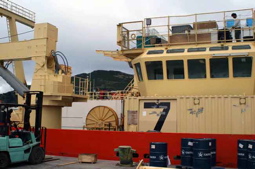The Trip South
The VIMS IVARS team continues south on the Nathaniel B. Palmer, the flagship research icebreaker of
the National Science Foundation. We presently are at 55°S and have traveled 600 nautical miles through open water.
Luckily, our weather has been good, with relatively calm winds, little swell, and cloudy skies.
But we all realize that weather conditions in these regions can change dramatically, so we remain aware of the
possibility of bad weather.
This year's IVARS cruise is being conducted in conjunction with another research effort, CORSACS. CORSACS will investigate the controls of algal composition, and in particular look at the interactive effects of iron, light and carbon dioxide. To do this, a group was assembled that includes Jack DiTullio (Charleston University), Rob Dunbar (Stanford), Dave Hutchins (Delaware), Pete Sedwick (Bermuda Biological Station), Philippe Tortell (British Columbia) and Mac Saito (Woods Hole), as well as Walker Smith of VIMS. They will use not only observations of in situ conditions (that is, seeing what algal species occur under various iron concentrations), they will experimentally manipulate natural waters (by adding iron and altering light and CO2) and establish algal cultures to see what species grow faster under the manipulated environments. It has been found in the equatorial Pacific that carbon dioxide had a tremendous impact on algal composition, with diatoms (common, large forms that have a characteristic shell made of silica) growing under low CO2, and another group dominated by a species called Phaeocystis dominating at high CO2. It was further speculated that this was due to the mechanism by which these groups acquire CO2 and their photosynthetic enzymes. Because these groups are important in the Ross Sea, and because carbon dioxide concentrations are changing rapidly in the ocean due to human releases into the atmosphere, controls by CO2 potentially could be critical throughout the entire ocean and influence food webs and elemental cycles.
IVARS will sample within this project, and occupy the same set of 12 stations in a transect roughly parallel to the Ross Ice Sheet that were sampled in previous years. We will also deploy two moorings to collect continuous data on nitrate and fluorescence, a measure of the numbers of algae in the water. The Ross Sea experiences substantial "blooms," or large accumulations of algae, during its short austral summer, and by knowing the rates of accumulation we can begin to understand the short-term variations and controls of algal growth. IVARS will recover the moorings in a separate, short cruise at the end of January and early February.
And the march south continues...

